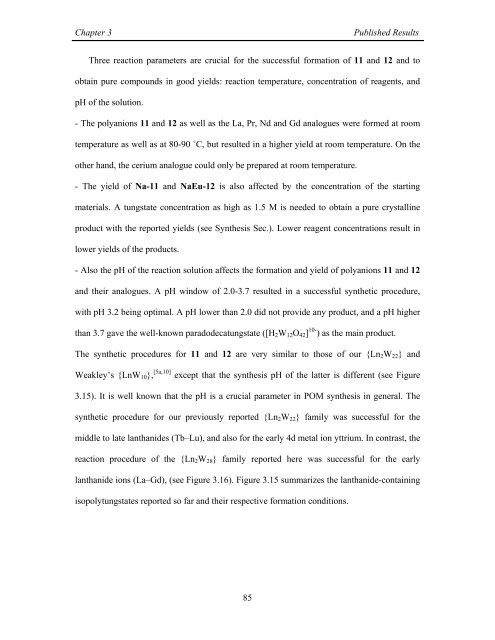Synthesis and Structural Characterization of ... - Jacobs University
Synthesis and Structural Characterization of ... - Jacobs University
Synthesis and Structural Characterization of ... - Jacobs University
You also want an ePaper? Increase the reach of your titles
YUMPU automatically turns print PDFs into web optimized ePapers that Google loves.
Chapter 3<br />
Published Results<br />
Three reaction parameters are crucial for the successful formation <strong>of</strong> 11 <strong>and</strong> 12 <strong>and</strong> to<br />
obtain pure compounds in good yields: reaction temperature, concentration <strong>of</strong> reagents, <strong>and</strong><br />
pH <strong>of</strong> the solution.<br />
- The polyanions 11 <strong>and</strong> 12 as well as the La, Pr, Nd <strong>and</strong> Gd analogues were formed at room<br />
temperature as well as at 80-90 ˚C, but resulted in a higher yield at room temperature. On the<br />
other h<strong>and</strong>, the cerium analogue could only be prepared at room temperature.<br />
- The yield <strong>of</strong> Na-11 <strong>and</strong> NaEu-12 is also affected by the concentration <strong>of</strong> the starting<br />
materials. A tungstate concentration as high as 1.5 M is needed to obtain a pure crystalline<br />
product with the reported yields (see <strong>Synthesis</strong> Sec.). Lower reagent concentrations result in<br />
lower yields <strong>of</strong> the products.<br />
- Also the pH <strong>of</strong> the reaction solution affects the formation <strong>and</strong> yield <strong>of</strong> polyanions 11 <strong>and</strong> 12<br />
<strong>and</strong> their analogues. A pH window <strong>of</strong> 2.0-3.7 resulted in a successful synthetic procedure,<br />
with pH 3.2 being optimal. A pH lower than 2.0 did not provide any product, <strong>and</strong> a pH higher<br />
than 3.7 gave the well-known paradodecatungstate ([H 2 W 12 O 42 ] 10- ) as the main product.<br />
The synthetic procedures for 11 <strong>and</strong> 12 are very similar to those <strong>of</strong> our {Ln 2 W 22 } <strong>and</strong><br />
Weakley’s {LnW 10 }, [5a,10] except that the synthesis pH <strong>of</strong> the latter is different (see Figure<br />
3.15). It is well known that the pH is a crucial parameter in POM synthesis in general. The<br />
synthetic procedure for our previously reported {Ln 2 W 22 } family was successful for the<br />
middle to late lanthanides (Tb–Lu), <strong>and</strong> also for the early 4d metal ion yttrium. In contrast, the<br />
reaction procedure <strong>of</strong> the {Ln 2 W 28 } family reported here was successful for the early<br />
lanthanide ions (La–Gd), (see Figure 3.16). Figure 3.15 summarizes the lanthanide-containing<br />
isopolytungstates reported so far <strong>and</strong> their respective formation conditions.<br />
85

















